Day 3 :
- Session 1: Electronic, Optical and Magnetic Materials
Location: Olimpica 1
Session Introduction
Henri Jaffres
Scientific Research National Center (CNRS), France
Title: Electrical spin injection and detection in molybdenum disulfide multilayer channel
Time : 09:00-09:20

Biography:
Henri Jaffrès completed his PhD in the Physics Department of the National Institute of Applied Sciences (INSA) - University Toulouse III, France, in 1999. He joined the Joint Physics Unit CNRS-Thales, France as a Post-doctoral Fellow (2000–2001). His work focuses on spintronics, spin injection, spin transport, and spin transfer in semiconductor spintronics devices with electrical and optical detection in III-V heterostructures, as well as spin-hall effect and spin-pumping in group IV semiconductors.
Abstract:
Molybdenum disulfide has recently emerged as a promising two- dimensional semiconducting material for nano-electronic and spintronic applications. However, the demonstration of an electron spin transport through ferromagnetic source and drain connecting a semiconducting MoS2 channel remains challenging. Here, the author will present the experimental evidence of the electrical spin-injection and spin-detection in the conduction band of a multilayer MoS2 semiconducting channel using a two terminal spin-valve configuration geometry. A magnetoresistance around 1% have been observed through a 450 nm long, 6 monolayer thick MoS2 channel with a Co/MgO tunneling spin injector and detector. It is found that keeping a good balance between the interface resistance and channel resistance is mandatory for the observation of the two-terminal magnetoresistance. Moreover, the electron spin-relaxation is found to be greatly suppressed in the multilayer MoS2 channel with an in-plane magnetization and spin-polarization. The long spin-diffusion length (approximately 235 nm) could open a new avenue for spintronic applications using multilayer transition metal dichalcogenides. In this talk, corollary to experiments, I will particularly emphasize on the mechanism of spin-injection at interfaces between a spin-polarized tunnel junction and a semiconductor channel, homogeneous or not. The latter can be composed of several regions, uniformly doped or depleted to form a Schottky contact and possibly location of a conduction made by hopping. I will extend the conditions for spin-injection from a spin- polarized ferromagnetic source into a Schottky contact on the ground of the experiments observed with success on MoS2 systems.
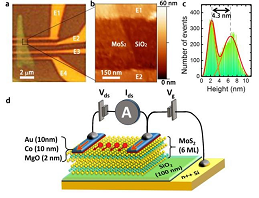
Figure 1: Multilayer MoS2-based lateral spin-valve device. (a) Optical image of the device with the multilayer MoS2 flake on 100 nm SiO2/Si(nþ þ) substrate, the E1, E2, E3 and E4 indicate the four Au/Co/MgO electrodes. (b, c) AFM measurement (in tapping mode) focused on the MoS2 channel between E1 and E2 electrodes. The thickness of MoS2 is determined by the Gaussian distribution of pixel height in the square region in b. (d) Schematics of the lateral spin-valve device. The multilayer MoS2 serves as a spin transport channel, and two Au/Co/MgO electrodes are used to inject spin (Vds) and measure the current (Ids). A back-gate voltage (Vg) between the substrate and one top contact is used to modulate the carrier density in MoS2.
Recent Publications:
1.A Fert, J M George, H Jaffrès, R Mattana (2007) Title. IEEE transactions on electron devices 54:5.
2.A Fert, H Jaffrès (2001) Title. Phys. Rev. B 64:184420.
3.M Tran, H Jaffrès, C Deranlot, J M George, A Fert, A Miard, A Lemaître (2009) Title. Phys. Rev. Lett. 102: 036601.
Vladimir A Gavrichkov
Federal Research Center KSC, Russia
Title: Microscopic background in metal-insulator criterion for doped Mott-Hubbard materials
Time : 09:20-09:40

Biography:
Vladimir A Gavrichkov has experience in the study of the electronic structure of strongly correlated materials: iron borates with spin S=5/2, manganites (S=2) and cuprates (S=1/2). His metal-insulator criterion creates a new conception of the dielectric state in doped materials with translational symmetry. He obtained the criterion as a result of the latest research in the field of many-electron effects in the electronic structure and exchange interaction of these materials. The approach is based on Hubbard’s quasiparticle picture and Wilson’s view on nature of the metal/dielectric state in itinerant electron system.
Abstract:
Statement of the Problem: The purpose of this study is to construct a metal–insulator criterion based on Wilson's ideas concerning a system of itinerant electrons in the analytical form for the doped Mott–Hubbard materials and also to associate a microscopic background of criterion with real properties of these materials.
Methodology & Theoretical Orientation: For our purposes, it is convenient to start with Lehmann's representation for the Green's function of the intra-cell Hamiltonian with respect to the family of single-particle operators and their matrix elements in the basis of eigenstates of (S and M are the spin and spin projection of the many-electron cell eigenstate), where index i runs over ,and states in the different sectors of configuration space in Figure from the work.
Findings: By following this approach, one obtains a simple metal– insulator criterion, which is characterized by the condition: the number of first removal electron (frs) states (-insulator) or (-metal) irrespective of the doped hole concentration x.
Conclusion & Significance: We suggest a non-adiabatic origin of the forbidden frs states and Ham’s effect for their matrix elements as the probable reasons for insulator state of the doped materials with translational symmetry.

Recent Publications:
1. Gavrichkov V A (2015) A simple metal-insulator criterion for the doped Mott-Hubbard materials. Sol. St. Comm. 208: 11-14.
2. Ovchinnikov S G, Gavrichkov V A, Korshunov M M, Shneyder E I (2012) LDA+GTB method for band structure calculations in the strongly correlated materials. Solid-State Sciences 171: 143-171.
3.Gavrichkov V A, Korshunov M M, Ovchinnikov S G, Shneyder E I, Orlov Yu S, Nekrasov I A, Pchelkina Z V (2012) Сuprates, manganites and cobaltites: multielectron approach to the band structure. Modern Physics Letters B26: 1230016.
4.Gavrichkov V A, Ovchinnikov S G, Pchelkina Z V, Nekrasov I (2010) Quasiparticles in CMR oxides in para- and ferromagnetic phases. Journal of Physics 200: 012046(1-4).
Rita Massa
University Naples Federico II, Italy
Title: An electromagnetic-thermal model for heating patterns prediction of microwave treated palm to contrast the Red Palm Weevil
Time : 09:40-10:00

Biography:
Rita Massa is professor of electromagnetic fields at the Department of Physics “Ettore Pancini” at the University of Naples Federico II, where she is the chief of the NIR-Billy (Non Ionizing Radiation –Biolectromagnetic) Laboratory. She as her expertise in the interactions of electromagnetic fields (overall radiofrequency and microwaves)with materials. Her research interests are biological effects of electromagnetic fields, electromagnetic dosimetry, electromagnetic fields exposure assessment (both numerical and experimental), therapeutic and industrial applications of microwaves, high power microwave applications, nondestructive testing of materials. The approach is basically experimental. The purpose applications focused on human health (biological systems) and monitoring (diagnostics) and control of materials and processes.
Abstract:
The invasive red palm weevil (RPW), Rhynchophorus ferrugineus Olivier is one of the most destructive pests of palms in the world. In the Mediterranean Basin, it spread slowly until 2004 but nowadays it can be found in almost all Mediterranean countries and it is particularly destructive for Phoenix canariensis palms. In the integrated pest management strategy, adopted to combat this pest, there is a considerable interest toward solutions able to control the pest with a minimum impact on the environment. Microwave/dielectric heating (MDH) is a technology that could meet this requirement by increasing the temperature of the insect until it dies, or its development capability is reduced, without damage the palm tissues. MDH is applied to insect control in food and we have shown its feasibility on infested palms. Heating patterns strongly depend on both electromagnetic and thermal properties that are related to the physiology of the plant. Results of dielectric spectroscopy and calorimetric measurements, carried out during microwave exposure of a healthy living palm, were employed to develop a simple electromagnetic-thermal code. It allows to predict the thickness of the annular area in “living” palms wherein the temperature reaches the lethal temperature for the insect, and how long it should stay in order to have a high probability that the treatment is successful without damaging the palm core that is the most relevant area for the life of the palm itself. The heating patterns predicted were found to agree well with the experimental and numerical results (obtained with acommercial software). It can be concluded that, MDH is a very promising and eco-compatible solution for contrasting the diffusion of RPW. The tool developed can be easily used by non-skilled operators for setting the parameters that can better guarantee the efï¬cacy of the treatment.

Figure 1: Electromagnetic-thermal model and experimental validation of a microwave treated palm.
Recent Publications :
1. Massa R, Panariello G, Pinchera D, Schettino F, Caprio E, Griffo R, Migliore M D (2017) Experimental and numerical evaluations on palm microwave heating for red palm weevil pest control. Scientific Reports 7: 45299.
2. Massa R, Migliore M D, Panariello G, Pinchera D, Schettino F, Caprio E, Griffo R (2014) Wide band permittivity measurements of palm (P. canariensis) and Rhynchophorus ferrugineus for RF pest control. J. Microwave Power and Electron Energy 48(3): 158-169.
3. Massa R, Caprio E, De Sanctis M, Griffo R, Migliore M D, Panariello G, Pinchera, Spigno P (2011) Microwave treatment for pest control: The case of Rhynchophorus ferrugineus in Phoenix canariensis. EPPO Bulletin 41(2): 128-135.
Satoshi Fujii
National Institute of Technology, Okinawa College, Japan
Title: Study on chemical reaction under microwave irradiation
Time : 10:00-10:20

Biography:
Satoshi Fujii received his BS and MS degrees in Material Science from Tsukuba University, Ibaragi, Japan, in 1985 and 1987, respectively. He received his PhD degree in Material Engineering from Kyoto Institute of Technology in 2007. In 1987, he joined Sumitomo Electric Industries and was involved in research on GaAs ICs in Opto-electronics Laboratories. Since 1992, he has been working on diamond SAW devices at the Itami Research Laboratories, Nagoya University. In 2004, he moved to the Advanced Technology Development Center, Seiko-Epson Corp., in order to study diamond SAW devices and related modules. In 2015, he joined the Faculty of the National Institute of Technology, Okinawa as a Professor.
Abstract:
Chemical reactions performed under microwave irradiation often demonstrate high reaction rates and high selectivities, which allows for more compact reactors and more energy-efficient processes than conventional heating methods. Consequently, our group has discovered a new chemical reaction, performed with a self-processing microwave irradiation source. We have proposed a solid-state microwave source with an ultra-precise oscillator and/or injection-locked magnetron that can be used to achieve reproducible results in microwave-mediated chemical reactions. These microwave effects can be classified into two types: thermal effects, which arise from the temperature increase caused by microwaves, and non-thermal effects, which are attributed to the interactions between the substances and the oscillating electromagnetic fields of the microwaves. For thermal effects, we have demonstrated that a silver-nanoparticle-coated polyimide thin film, which was synthesized via a microwave–mediated sintering process, displayed conductivity seven-fold greater than that of the film formed in a conventional furnace. We have developed a novel microwave-driven Pidgeon process to produce Mg metal with less energy consumption and no direct CO2 emission. An antenna structure, consisting of dolomite as the Mg source and a ferrosilicon antenna as the reductant, was used both to confine the microwave energy emitted from the magnetron in the microwave oven and to produce a practical amount of pure Mg metal. This microwave Pidgeon process with an antenna configuration made it possible to produce Mg with an energy consumption of 58.6 GJ/t, corresponding to 68.6% reduction compared to the conventional method. For non-thermal effects, we demonstrated the microwave-enhanced electrolysis of water to generate O2 using a α-Fe2O3 electrode with induction by pulsed microwave irradiation under a constantly applied potential.
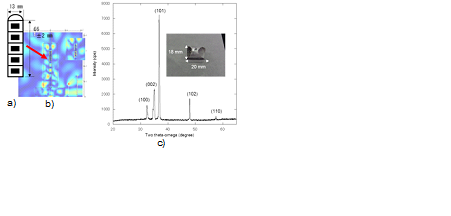
Figure 1: a) Antenna structure and b) Electric field distribution in the applicator, and c) X-ray diffraction and photo image of Mg obtained by microwave Pidgeon method.
Recent Publications:
1.Fujii S (2014) Chemical reaction under highly precise microwave irradiation. Journal of Microwave Power and Electromagnetic Energy 48: 89-103.
2.Fujii S (2016) Injection-locked magnetron using a cross-domain analyzer. IEEE Microwave and Wireless Components Letters 26: 966-968.
3.Fujii S (2015) Microwave sintering of Ag-nanoparticle thin films on a polyimide substrate. AIP Advances 5: 1-11.
4.Wada Y, Fujii S (2017) Smelting magnesium metal using a microwave Pidgeon method. Sci. Rep. 7: 46512.
5. Kishimoto F, Fujii S (2016) Enhancement of anodic current attributed to oxygen evolution onα-Fe2O3 electrode by microwave oscillating electric field. Sci. Rep. 6: 35554.
Gaspare Varvaro
ISM-CNR, Italy
Title: L10-FePt based systems for ultra high-density magnetic recording
Time : 10:20-10:40

Biography:
Gaspare Varvaro has done his PhD in Material Science 2007, University “La Sapienza” of Roma, Italy. He works as a CNR Researcher since 2010. He is a member of the Nanostructured Magnetic Material Lab (ISM – CNR) and Head of the Thin Film Deposition Lab since 2015. His interests span from the fabrication to the characterization of magnetic and magneto-transport properties and their correlation with morpho-structural properties of nanostructured magnetic materials including single-phase, magnetic composites and hybrid/multifunctional systems (thin films, multilayers, nanoparticles and nano-patterned systems) for fundamental studies and applications (information storage, energy, sensors and biomedicine). His research activity is witnessed by more than 40 papers on ISI journals and conference proceedings and 2 book chapters. He is co-editor of a book titled “Ultra-High-Density Magnetic Recording: Storage Materials and Media Designs”.
Abstract:
The demand for digital storage devices is continuously growing in response to the extraordinary increase of the volume of data created worldwide, which would reach the value of 40 zettabytes in 2020. Among the different storage devices currently available, the hard disk drive (HDD), based on the magnetic recording technology, remains the most convenient (cost/GB 0.02 $) and diffusive devise (~400 millions of units sold in 2016) for massive digital data storage. Currently available HDDs using CoCrPt:SiO2 granular thin films with perpendicular magnetic anisotropy are reaching their physical limit (~1 Tbit/in2 recording density) due to thermal fluctuations that hinder a further reduction of in-plane grain size (to 4–5 nm) needed to scale down the bit size. L10-FePtX alloy is currently considered the most promising candidate for future recording media with areal densities above 1 Tbit/in2 thanks to its high magneto-crystalline anisotropy, which enables it to be thermally stable even at grain sizes down to 3 nm. However, its huge anisotropy implies an increase of the switching field, which cannot be afforded by current available write heads. The writability and thermal stability requirements can be simultaneously addressed by using exchange coupled composite systems, combining two or multiphase magnetic hard and soft materials, where the hard phase provides thermal stability and the soft phase reduces the switching field. An alternative approach involves the use of so-called bit patterned media, which consist of an ordered two-dimensional array of individual magnetic nanostructures with perpendicular anisotropy, each of them representing one bit of information, obtained by nanolithography and/or self-assembly techniques. This communication reports on the fabrication and physical properties of FePtX-based thin films and nanoparticles of potential interest for next generation recording media based on exchange coupled composite materials and bit patterned magnetic recording technology.
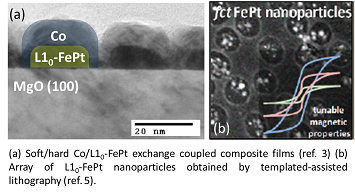
Recent Publications:
1.Varvaro G, Casoli F Eds (2016) Ultra-high-density magnetic recording: Storage materials and media designs. Pan Stanford Publishing.
2.Barucca G, Speliotis Th, Giannopoulos G, Niarchos D, Rutkowski B, Czyrska-Filemonowicz A, Agostinelli E, Laureti S, Testa A M, Varvaro G (2017) Magnetic anisotropy phase-graded A1/L10-FePt films on amorphous glass substrates. Mat. Design 123: 147.
3.Varvaro G, Laureti S, Fiorani D (2014) L10 FePt-based thin films for future perpendicular magnetic recording media. JMMM 368: 415.
4.Faustini M, Capobianchi A, Varvaro G, Grosso D (2012) highly controlled dip-coating deposition of fct FePt nanoparticles from layered salt precursor into nanostructured thin films: An easy way to tune magnetic and optical properties. Chem. Mater. 24: 1072.
Szymon Chorazy
Jagiellonian University, Poland
Title: Photoluminescent crystalline magnetic materials based on trivalent lanthanide ions and polycyanidometallates
Time : 10:40-11:00

Biography:
Szymon Chorazy is an Assistant Professor in Inorganic Molecular Materials Group at the Jagiellonian University in Krakow, Poland, and Collaborative Researcher in Solid State Physical Chemistry Group at The University of Tokyo, Japan. He has received his PhD from Jagiellonian University under the supervision of Professor Barbara Sieklucka and Professor Shin-ichiOhkoshi from the University of Tokyo. He joined as a Project Assistant Professor in the Department of Chemistry, School of Science, University of Tokyo. Later, he joined Professor Barbara Sieklucka’s Group working as an Assistant Professor. His research interests cover the design, preparation and physico-chemical characterization of novel functional magnetic materials revealing various optical, magneto-optical, and phase transition properties.
Abstract:
Photo- and electroluminescence induced in solid-state materials arouse a remarkable interest due to a number of applications in light-emitting devices, optical communication, tunable laser systems, low-energy scintillation, energy conversion, chemical sensing, and bioimaging. Thus, there is a strong need to design and prepare new functional materials exhibiting efficient light-emitting functionalities, including white-light emission, near-infrared phosphorescence, multi-colored switchable emission, or up-conversion luminescence. Another exciting idea is to synthesize multifunctional luminescent materials that combine strong photoluminescence with other physical properties. In this regard, the conjunction of magnetic and emission phenomena are particularly attractive due to the expected cooperative effects, and the possibility of tuning light emission by a magnetic field. We present two main strategies toward bifunctional photoluminescent and magnetic materials, both realized within the family of heterobimetallic coordination polymers built of polycyanidometallates, [MV(CN)8]3-(M=Mo, W) and [MIII(CN)6]3- (M=Cr, Co), which serve as metalloligands to complexes of trivalent lanthanide ions with selected organic molecules. In the first approach, we present the synthetic route toward emissive molecule-based ferromagnets based on bimetallic octacyanido-bridged Tb-W and Tb-Mo, and hexacyanido-bridged Nd-Cr assemblies. They combine a long-range ferromagnetic ordering with the visible or near-infrared emission, depending on the applied lanthanide (3+) ions. Our second approach explores a strong magnetic anisotropy of Dy3 complexes leading to the effect of slow magnetic relaxation, which is named a single-molecule magnet (SMM) behavior. We embedded the Dy3 SMMs into bimetallic cyanido-bridged Dy-Co coordination networks producing the magneto-luminescent materials combining significant magnetic anisotropy with white light emission, or multi-colored visible emission tunable by the excitation light.
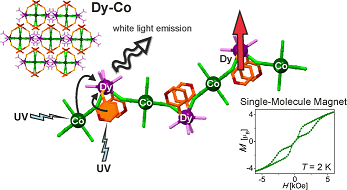
Recent Publications:
1.Chorazy S, Rams M, Nakabayashi K, Sieklucka B, Ohkoshi S (2016) White light emissive Dy3 single-molecule magnets sensitized by diamagnetic [Co3(CN)6]3- Linkers. Chemistry – A European Journal 22: 7371-7375.
2.Chorazy S, Wang J, Ohkoshi S (2016) Yellow to greenish-blue color-tunable photoluminescence and 4f-centered slow magnetic relaxation in a cyanido-bridged Dy3(4-hydroxypyridine)-Co3 layered material. Chemical Communications 52: 107595-10798.
3.Chorazy S, Sieklucka B, Ohkoshi S (2016) Near-infrared photoluminescence in hexacyanido-bridged Nd-Cr layered ferromagnet. Crystal Growth & Design 16: 4918-4925.
4.Chorazy S, Arczynski M, Nakabayashi K, Sieklucka B, Ohkoshi S (2015) Visible to near-infrared emission from Ln3(Bis-oxazoline)-[MoV(CN)8] (Ln=Ce-Yb) magnetic coordination polymers showing unusual lanthanide-dependent sliding of cyanido-bridged layers. Inorganic Chemistry 54: 4724-4736.
5.Chorazy S, Nakabayashi K, Ohkoshi S, Sieklucka B (2014) Green to red luminescence switchable by excitation light in cyanido-bridged Tb3-WVFerromagnet. Chemistry of Materials 26: 4072-4075.
Masato Kotsugi
Tokyo University of Science, Japan
Title: Rare-metal-free super magnet L10-type FeNi ordered alloy
Time : 11:15-11:35

Biography:
M Kotsugi has his expertise in surface and interface magnetism based on molecular beam epitaxy and synchrotron radiation. He received his PhD based on surface electron diffraction thesis from Osaka University. He joined Max Planck Institute in 2001 as a Post-doctorate, where he worked in the field of Multilayer Magnetism. He is currently heading the Electronic Solid State Engineering Laboratory in Tokyo University of Science.
Abstract:
For the realization of low carbon society, development of advanced magnetic materials has been rapidly progressed in this decade. Especially, rare-metal-free-super magnet is key material of electric vehicles and renewable energy, to increase conversion efficiency and reduce environmental load. L10-type FeNi(Co) order alloy is a candidate of such advanced magnetic material. L10-FeNi is described as an ordered alloy, in which Fe and Ni single atomic layers are alternately stacked along the c-axis direction. Its predicted magnetic anisotropy energy is 1×107 erg/cc and magnetic moment is 1200 emu/cc. Magnetic anisotropy is known to correlate strongly with lattice structure and electronic structure. However, the study of local magnetic moment and surface morphology has not been satisfactorily carried out so far.  In this work, we report: (1) the construction of pulsed-laser-deposition (PLD) system, (2) fabrication of L10-FeNi(Co) by alternate monoatomic layer deposition and (3) macroscopic and microscopic characterization of L10-FeNi(Co) thin film. We examine the perpendicular magnetization by using super quantum interference device (SQUID) and photoemission electron microscope (PEEM). Magnetization curve was measured using SQUID. Result of SQUID shows that saturation magnetization (Ms) of 265 emu/cc, out-of-plane magnetization is greater than in-plane magnetization therefore; easy axis of magnetization is out-of-plane. Magnetic domain observation was carried out by photoelectron emission microscope utilizing X-ray magnetic circular dichroism (XMCD-PEEM) at soft X-ray undulator beamline BL17SU of SPring-8. Results of XMCD shows maze-pattern was confirmed (Fig.1). This behavior is clearly different from magnetic domain with B2-FeCo with in-plane magnetization. We suggest that FeCo film obtains perpendicular magnetization with spontaneous magnetization.
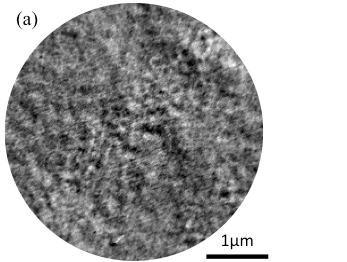
Tokiyoshi Matsuda
Ryukoku University, Japan
Title: Rare-metal-free high-performance Ga-Sn-O thin film transistor
Time : 11:35-11:55

Biography:
Tokiyoshi Matsuda has his expertise in fabricating amorphous oxide semiconductor materials, evaluation of defects in the oxide semiconductor, and its TFT application. He proposed the model of oxygen vacancy in IGZO. Novel material of Ga-Sn-O was fabricated to avoid the use of rare metal material of In, and Zn which may cause the device instability. These oxide semiconductors are suitable for use in novel devices not only next-generation displays, but also power devices and artificial intelligence devices such as neural networks.
Abstract:
Oxide semiconductors have been investigated as channel layers for thin film transistors (TFTs) which enable next-generation devices such as high-resolution liquid crystal displays (LCDs), organic light emitting diode (OLED) displays, flexible electronics, and innovative devices. Here, high-performance and stable Ga-Sn-O (GTO) TFTs were demonstrated for the first time without the use of rare metals such as In. Substituting Sn for In is a reasonable countermeasure for avoiding the use of rare earth metals. Moreover, In and Sn have similar electronic structures and electrical properties. The GTO TFT was fabricated on a Si wafer with thermal oxide. The GTO thin films were deposited using radiofrequency (RF) magnetron sputtering. A high field effect mobility of 29.9 cm2/Vs was achieved as shown in Figure 1. The stability of the GTO TFTs was examined under bias, temperature, and light illumination conditions. The electrical behavior of the GTO TFTs was more stable than that of In-Ga-Zn-O (IGZO) TFTs, which was attributed to the elimination of weak Zn-O bonds. High field effect mobility TFT with a low S factor was prepared using GTO, where the rare earth In was replaced by Sn. The stability of the GTO TFT without a passivation film under various accelerated operating conditions was significantly higher than that of equivalent IGZO TFTs. Although we compared the IGZO and GTO TFTs fabricated in our laboratory just for evaluation of the materials themselves, because TFT characteristics are influenced by the treatment of backchannel such as passivation materials and methods, and surface treatment the effective treatments for IGZO TFT can also be effective for GTO TFT. We propose such GTO TFTs as key devices suitable for use in next-generation technologies such as displays, power devices, and artificial intelligence devices such as neural networks.
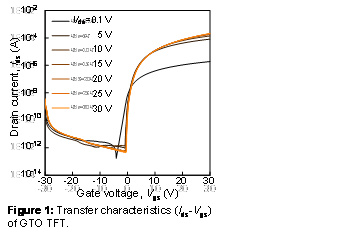
Recent Publications
1. Tokiyoshi M, Kenta U, Yuta K, Daiki N, Mutsumi K (2017) Rare-metal-free high-performance Ga-Sn-O thin film transistor. Scientific Reports 7: 44326.
2.Mutsumi K, Takaaki M, Akito Y, Tokiyoshi M, Tokuro O, Koji A, Chih-Che K (2016) Hall effect in thin-film transistor. IEEE Transactions on Electron Devices 63: 3335 – 3337.
3.Tokiyoshi M, Mutsumi K (2015) Comparison of defects in crystalline oxide semiconductor materials by electron spin resonance. Journal of Vacuum Science and Technology A 33: 020601.
Luca Fausto Tocchio
International School for Advanced Studies, Italy
Title: Ferroelectricity and magnetism in the organic charge transfer salts κ-(ET)2X
Time : 11:55-12:15

Biography:
Luca F Tocchio is a Researcher at the Institute for Condensed Matter Physics and Complex Systems of Politecnico di Torino. He has worked as a Post-doctoral fellow at the University of Frankfurt and at the International School for Advanced Studies (SISSA) in Trieste, where he also did his PhD. He works on numerical Monte Carlo simulations of models for strongly correlated electron systems, aiming to study topics like high-temperature superconductivity, spin-liquid phases, interplay between charge and magnetic degrees of freedom. He is also interested in methodological improvements of variational wave functions to better describe correlated electron systems.
Abstract:
The molecular conductors κ-(ET)2X, where ET denotes an organic molecule and X is an anion, exhibit electronic ferroelectricity, where charge order breaks inversion symmetry, accompanied by the onset of magnetic order. These materials can be modeled by a 3/4 filled extended Hubbard model on a two-orbital anisotropic triangular lattice (see figure), where the molecular degrees of freedom are explicitly taken into account. The model is theoretically investigated by the variational Monte Carlo method. By studying the effect of the competing inter-site Coulomb interactions, we determine charge order patterns and how these charge orders generate emergent magnetic order. In particular, we find three charge ordered phases, namely, a nonpolar insulating one, a polar insulating one, leading to ferroelectricity, and a charge-ordered metallic phase with a 3-fold geometry. The charge ordered phases are accompanied by the presence of magnetic order that is more enhanced within the polar phase.
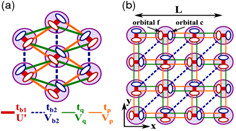
Recent Publications
1.R Kaneko, L F Tocchio, R Valentí, C Gros (2016) Emergent lattices with geometrical frustration in doped extended Hubbard models, Phys. Rev. B 94, 195111.
2.E Ghorbani, L F Tocchio, F Becca (2016) Variational wave functions for the S=1/2 Heisenberg model on the anisotropic triangular lattice: Spin liquids and spiral orders, Phys. Rev. B 93: 085111.
3.L F Tocchio, C Gros, X F Zhang, S Eggert (2014) Phase diagram of the triangular extended Hubbard model. Phys. Rev. Lett. 113: 246405.
4. L F Tocchio, H Feldner, F Becca, R Valentí, C Gros (2013) Spin-liquid versus spiral-order phases in the anisotropic triangular lattice. Phys. Rev. B 87: 035143.
Mina Yoon
University of Tennessee, USA
Title: Materials by design for thermodynamically stable electrides
Time : 12:15-12:35

Biography:
Mina Yoon received her PhD degree in Theoretical Condensed Matter Physics in 2004, from Michigan State University. She is a Research Scientist at ORNL and a Joint Professor of Physics at University of Tennessee, Knoxville. The primary focus of her research lies in the fundamental understanding of growth mechanisms, novel properties, functionalization, and potential technological applications of surface-based and low-dimensional materials. Especially, her interest is in utilizing these materials as light, environmentally friendly, and efficient energy storage/generation and optoelectronic application by making use of their unique low-dimensional properties. Her theoretical approach ranges from atomistic modeling by first-principles quantum mechanical approaches and many-body potential approaches, to continuum elasticity theory and phenomenological modeling.
Abstract:
Two-dimensional (2D) electrides, emerging as a new type of layered material whose electrons are confined in interlayer spaces instead of atomic proximities, are receiving interest for their high performance in various optoelectronics and catalytic applications. A realization of electrides containing anionic electrons has been a great challenge because of their thermodynamic stability. For example, experimentally, only a couple of layered nitrides and carbides have been identified as 2D electrides. Here, we report new thermodynamically stable low-dimensional (1D and 2D) electrides by using first-principle global structure optimization method, phonon spectrum analysis, and molecular dynamics simulation. The method was applied to binary compounds consisting of alkaline-earth elements as cations and group VA, VIA, or VIIA nonmetal elements as anions, and further extended to less than ~100 K materials in databases. We demonstrated a new avenue to discover new electrides and provide new design principles, which will significantly boost the discovery of this new class of material with great technical application.
Recent Publications:
1.W Ming, M Yoon, M H Du, F Liu, K Lee, S W Kim (2016) Two-dimensional electrides predicted by global structure optimization. J. Am. Chem. Soc. 138: 15336.
2.Mahjouri Samani Masoud et al. (2016) Tailoring vacancies far beyond intrinsic levels changes the carrier type in monolayer MoSe2-x crystals vacancy induced anomalies in optical and electric properties of se-deficient MoSe2 monolayers beyond intrinsic levels. Nano Lett. 16: 5213.
3.Zhequan Yan, Liang Chen, Mina Yoon, Satish Kumar (2016) Phonon transport at the interfaces of vertically stacked graphene and hexagonal boron nitride heterostructures. Nanoscale 8: 4037.
4.Bing Huang, Mina Yoon, Bobby G Sumpter, Su-Huai Wei, Feng Liu (2015) Alloy engineering of defect properties in semiconductors: suppression of deep levels in 2D transition-metal dichalcogenides. Phys. Rev. Lett. 115: 126806.
5.S R Wagner, B Huang, C Park, J Feng, M Yoon, P Zhang (2015) Growth of metal phthalocyanine on deactivated semi-conducting surfaces steered by selective orbital coupling. Phys. Rev. Lett. 115: 096101.
Yuma Nakamura
Tsinghua University, China
Title: Intrinsic charge transport in stanene: Role of buckling and electron-phonon coupling
Time : 12:35-12:50

Biography:
Yuma Nakamura is now pursuing two Master degrees in the Department of Chemistry, Tsinghua University, China and Department of Physics, Tohoku University, Japan in double degree program. He received his BSc (2015) in the Department of Physics, Tohoku University. He has worked as a Reviewer of peer reviewed Journal of Material Research. His research interest covers computational chemistry, two-dimensional materials, and charge and spin transport phenomena. He has his expertise in density functional theory (DFT) and density functional theory (DFPT) for simulating material property.
Abstract:
Among two-dimensional materials, group IV elemental sheets such as graphene, silicene, germanene and stanene have been intensively investigated using first principles calculation. We look at the intrinsic carrier mobility for stanene, or the tin-monolayer, using Boltzmann transport equation coupled with density functional perturbation theory plus Wannier interpolation approximation to consider electron scattering with all the phonon branches with dispersion contribution. It is found that the conventional deformation potential (DP) approach which worked well for many layered materials, can well overestimate the carrier mobility in stanene because the buckled structure allows more types of electron-phonon scattering, such as acoustic flexural mode. DP theory assumed that only longitudinal acoustic phonon in long wavelength limit (|q|∼0) contributes to the charge relaxation process. In this work, we calculate all phonon modes, such as out-of-plane acoustic mode, transverse acoustic mode, and optical counterparts, in addition to longitudinal acoustic mode, plus dispersion effects and we investigate the intrinsic carrier mobility, in comparison with the DP theory. We find that the intrinsic carrier mobility could be as high as 2~3x106 cm2 V−1 s−1 by DP theory but becomes only 2~3x103 cm2 V−1 s−1 by the full evaluation of electron-phonon coupling. It is found that the intervalley scattering process in acoustic out-of-plane and transverse mode, which DP ignored dominate the carrier relaxation.
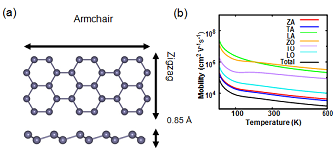
Recent Publications:
1. Yuma Nakamura, Tianqi Zhao, Jinyang Xi, Wen Shi, Dong Wang, Zhigang Shuai (2017) Intrinsic Charge Transport in Stanene: Roles of Bucklings and Electron-Phonon Couplings. Computational Physics
- Session 2: Emerging Smart Materials | Materials for Energy and Environmental Sustainability
Location: Olimpica 1
Session Introduction
Tsvetanka Zheleva
US Army Research Lab, USA
Title: Materials research in energy and power for defense
Time : 13:30-13:50

Biography:
Tsvetanka S Zheleva is the Associate Chief for the Energy and Power Division at ARL. Her expertise is in the areas of Applied Physics and Materials Science. She has published her research in over 150 publications in the areas of thin film physics, semiconductor materials and devices, interface engineering, structural analysis of device heterostructures. She holds 12 patents and her work are cited over 4000 times in peer reviewed journals and patent literature.
Abstract:
The demand for improved performance, increased power and energy densities, and reduced cost, size, and weight, drive the materials research focus of the Energy and Power (E&P) programs at the US Army Research Laboratory (ARL). An overview of ARL’s relevant broad range, major programs will be presented, with emphasis on three key areas of materials research: 1) Chemical energy materials: electrochemical storage materials, materials for fuel cells, advanced battery chemistry materials, photoelectrochemistry materials; 2) Power science: WBG materials and devices, compact power materials and devices, science of thermal materials, alternative energy materials; and 3) Power integration: reliability of WBG materials and devices, integrated power/thermal device packaging. Examples from our advancements in each of the key areas employing numerous materials characterization and modeling approaches will be presented: Chemical energy materials: the development of novel “water-in-salt” electrolytes enabling high-voltage aqueous lithium-ion chemistries, derivation of the optimal substitution of the LCP achieving exceptional stability, high capacity, lower fade, and increased thermal stability; Power science: identified a transition layer at the SiC/silicon oxide interfaces of power field effect transistors relevant to their mobility parameters, development of ferrofluid-based stretchable magnetic core inductors, experimentally demonstrated and characterized mechanisms for nuclear isomer depletion that by-pass the slow nuclear decay transitions; and Power integration: identification of SiC voltage threshold instabilities leading to revised standards for device test and characterization, and others. Much of our research is performed in close collaboration with our partners from DOE and DoD labs, academia and industry. A brief summary of the various collaborative opportunities with ARL will be presented at the end.

Figure 1: “Water-in-Salt” aqueous Lithium ion battery technology that could provide power, efficiency and longevity comparable to today's Lithium-ion batteries
Recent Publications:
1. J Taillon, K Gaskell, G Liu, L Feldman, S Dahr, T Zheleva, A Lelis (2015) Characterization of the oxide-semiconductor interface in 4H-SiC/SiO2 structures using TEM and XPS. Microscopy and Microanalysis 21(S3): 1537-1538.
Antonina Pirrotta
University of Palermo, Italy
Title: A new perspective for analyzing experimental tests on biomaterials
Time : 13:50-14:10

Biography:
Antonina Pirrotta has graduated in Civil Engineering from the Palermo University in 1987. She has done her PhD in Structural Engineering in 1996 and as Post-doctoral studies in 1998. In 2000, she became a Researcher, in 2001 Associate Professor and in 2016 Full Professor in the Structural Engineering department at the University of Palermo. She is the author and co-author of about 90 scientific papers dealing with the following fields: stochastic dynamics, active and passive control, stochastic differential calculus. Since 2014, she is a Professor in the Department of Mathematical Sciences, University of Liverpool, UK.
Abstract:
Given the increasing interest for the biomaterials in medical and engineering field, the objective of this talk is the theoretical and experimental analysis of the biomaterials in order to define experimental procedures and mathematical models suitable for their mechanical characterization. The biomaterials exhibit a rheological behavior intermediate between that of purely elastic materials and that of the purely viscous materials and therefore are called viscoelastic ones. In the past the “classical” models as Maxwell and Kelvin-Voigt have been used to capture viscoelastic phenomena. However, these models are not consistent to model the viscoelastic behavior of real materials, since the Maxwell type can capture the relaxation tests only and the Kelvin-Voigt the creep tests. A more realistic description of creep and/or relaxation is given by a power law function with real order exponent. As soon as we assume a power law function for creep, the constitutive law relating deformation and stress is ruled by a Riemann-Liouville fractional integral with order equal to that of the power law. In this regard, recent studies have been stressed that the most suitable model for capturing the viscoelastic behavior is the spring-pot, characterized by a fractional constitutive law. Based on the aforementioned considerations, it is apparent that the need of theoretical as well as experimental development and exploration of materials with novel physical characteristics. For instance, if the giant grass Arundo donax (AD) has to be characterized; then, attention is devoted on searching a proper model for characterizing the behavior of giant reeds. To aim at this, firstly, meticulous experimental tests have been performed in the Laboratory of structural materials of University of Palermo. Further a novel aspect of using an advanced Euler-Bernoulli model to fit experimental data of bending tests will be introduced.
Recent Publications:
1.Celauro C, Fecarotti C, Pirrotta A (2017) An extension of the fractional model for construction of asphalt binder master curve. European Journal of Environmental and Civil Engineering 21(1): 78-93.
2.Di Lorenzo S, Di Paola M, La Mantia F, Pirrotta A (2016) Non-linear viscoelastic behavior of polymer melts interpreted by fractional viscoelastic model. Meccanica, DOI: 10.1007/s11012-016-0526-8
3.Bucher C, Pirrotta A (2016) Dynamic finite element analysis of fractionally damped, structural systems in the time domain. Acta Mechanica 226(12): 3977-3990.
4.Pirrotta A, Cutrona S, Di Lorenzo S, Di Matteo A (2015) Fractional viscoelastic Timoshenko beam deflection via single equation. International Journal for Numerical Methods in Engineering 104(9): 869-886.
5.Cataldo E, Di Lorenzo S, Fiore V, Maurici M, Nicoletti F, Pirrotta A, Scaffaro R, Valenza A (2015) Bending test for capturing the vivid behavior of giant reeds, returned through a proper fractional viscoelastic model. Mechanics of Materials 89: 159-168.
Alexander Axelevitch
Holon Institute of Technology, Israel
Title: Solar cells efficiency enhancement by plasmons generation
Time : 14:10-14:30

Biography:
Alexander Axelevitch has completed his PhD in Physical Electronics from Tel-Aviv University, Tel-Aviv, Israel in the year 2002. Since 1995, he has been working at the Holon Institute of Technology (HIT). He currently leads the Nanotechnology and Microelectronics Branch of the Engineering Faculty, the Laboratory of Microelectronics and Thin Films; and works as a Senior Lecturer in Faculty of Engineering at the Holon Institute of Technology. His main research interest includes thin films deposition methods, transition metal oxides, alternative energy sources, solar cells and plasmonic effects. He has eight patents, 67 referred articles and more 150 papers presented at many scientific meetings.
Abstract:
The urgent need to develop alternative energy source focuses the attention on solar energy as a solution for this problem. The sun represents an infinite renewable energy source, thus making it most attractive. Unfortunately, the efficiency of photovoltaic (PV) converters is limited due too high electrical and optical losses. It is known that each photon can produce only one pair of charged carriers. This is one of the most important factors limiting the efficiency of solar cells. In order to increase the efficiency of PV conversion, it is necessary to increase the number of charged particles generated by absorption of a single photon. For this goal, we apply the nano-structured metal thin films which capable to form a localized surface plasmon resonance (plasmon) in each metal nanoparticle under light illumination. A plasmon represents an ensemble of free electrons (holes) oscillating coherently inside the metal nanoparticles and can be considered as a source of additional electrons obtained due polarization of these metal nanoparticles. If the nanostructured metal thin film will be embedded in the p/n junction of a diode PV structure, we may to create the conditions which help to transfer additional electrons excited by light illumination to the conductive band of the applied semiconductor. This effect has been experimentally tested in our laboratory in different PV structures containing gold and silver nanoparticles. It was found that island thin metal films deposited by sputtering and embedded into the p/n junction significantly influence of the PV structure efficiency and the type of metal defines its behavior. The power generated in the heterojunction structures In2O3-Si with the gold island interlayer increases more than to 10 times comparing with the structure without gold nanoparticles. This technology may be applied for all types of inorganic solar cells.
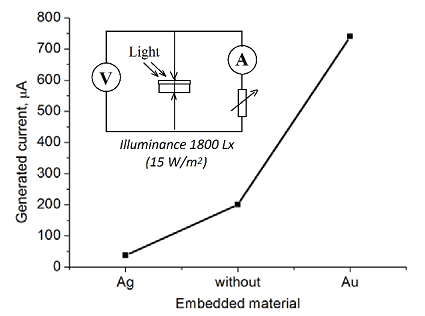
Figure 1: Comparison of the short-circuit current in different PV structures.
Recent Publications:
1.Axelevitch Alexander (2016) Application of embedded metal nanostructures for solar cells. International Journal of Renewable Energy Sources 1: 32-37.
2. Axelevitch A, Apter B (2015) In-situ investigation of optical transmittance in metal thin films. Thin Solid Films 591: 261-266.
3.Golan G, Axelevitch A, Azoulay J (2014) Properties investigation of thin films photovoltaic hetero-structures. World J. of Engineering 11(3): 233-238.
4.Axelevitch A, Gorenstein B, Golan G (2014) Application of gold nano-particles for silicon solar cells efficiency increase. Applied Surface Science 315: 523-526.
5. Axelevitch A, Palankovski V, Selberherr S, Golan G (2015) Investigation of novel silicon PV cells of a lateral type. Silicon 7(3): 283-291.
Shivani Bhardwaj Mishra
University of South Africa, South Africa
Title: Sustainable solutions for industrial waste minimization: Environmental and material applications
Time : 14:30-14:50

Biography:
Shivani Bhardwaj Mishra is working as a Professor in Nanotechnology and Water Sustainability Unit at University of South Africa. She is currently the Group Leader for the research on sol-gel science and technology, polymer ceramic composites/nanocomposites, organic-inorganic hybrid systems and its application for water research. She has an experience of more than 12 years in teaching undergraduate and post-graduate students and has supervised doctoral and master’s students. She has delivered a number of plenary, keynote, invited lectures and expert talks. She has published 81 research articles in scientifically accredited international journals and is the author of 33 book chapters
Abstract:
Waste minimization is global challenge for industries and environmental protection agencies to compete in the business through sustainable solutions. Numerous works has been done and also being carried to reduce the levels of solid and liquid waste and possibly be reutilized for various applications. Some of the work includes utilization of waste glass materials and sand for decontamination of heavy metal ions and then fabricating the residual waste into a glass. Initially sand was modified and reconstructed to suit to the composition required for glass preparation. The reconstructed san and glass fiber waste was used to uptake hexavalent chromium from electroplating waste water and then later the used up adsorbent was melted to colored glass. In another study, fly ash from local power station was used for developing pozzolanic materials for concrete production. The results show that flyash composite with cyclodextrin formed composite with competitive pozzolanic features that can be incorporated into cement for concrete production. Lignin is a natural polymer that is found in abundance in pulp and paper mill industrial waste water. This was used to develop composite material for adsorption for removal of various contaminants from waste water.
Helena Zapolsky
University of Normandy, France
Title: Quasi particle approach to study the kinetics of self-assembly in complex material
Time : 14:50-15:10

Biography:
Helena Zapolsky is a Professor of Theoretical Physics at Rouen University, Her main research interest lies in theoretical understanding of the emergence of patterns formation and kinetics of phase transformation in different type of materials. Applying different mathematical and computational approaches to diverse problems in materials science she developed an original multiscale tool to study phase transformations in materials. Recently, she proposed a novel statistical-mechanical approach to model a spontaneous self-assembling of randomly distributed atoms into pre-determined atomic structures of almost any complexity. The modeling based on the proposed theory is at atomic resolution, and addresses the time scale commensurate with a typical diffusion time, which may range from a fraction of a second to years. This method has been applied to describe the segregation at grain boundaries, self-assembly of the randomly distributed monomers into single- strand and double-stranded helixes and phase transformations in binary and ternary alloys.
Abstract:
Statement of the Problem: A self-organisation is a universal phenomenon in nature and, in particular, is highly important in materials systems. Our goal was to develop a new theory that provides a computationally effective approach to this problem.
Methodology & Theoretical Orientation: The proposed theory rests on two novel conceptual premises: (a) the introduction of interacting pseudoparticles that we call fratons that described two configurational states of each point of continuum space. The fratons are considered as a non-ideal gas whose "condensation” describes a diffusional self- assembling of atomic system, and (b) a concept of a structural cluster function describing the directions, length and strength of interatomic bonds. The latter allows us to formulate a new and simple model Hamiltonian. This model Hamiltonian provides the formation of a predetermined atomic structure and has a sufficient flexibility to describe the desired mechanic and thermodynamic properties of this structure.
Findings: The modeling based on the proposed theory is at atomic resolution, and addresses the time scale commensurate with a typical diffusion time, which may range from a fraction of a second to years. To demonstrate a potentiality and versatility of our approach, we tested its application to a self-assembling of disordered systems to three groups of systems of increasing topological complexity, viz., single component crystals (fcc, hcp and diamond structures), two component crystals (zinc-blend structure), self-assembly of the randomly distributed monomers into single-strand and double-stranded helixes and grain boundaries structure. The spontaneous self- organisation of fratons into the diamond structure.
Conclusion & Significance: The developed approach opens a way to answer numerous outstanding questions concerning the atomistic mechanisms of the formation of defects (dislocations, grain boundaries, etc.), nucleation in solid–solid transformations, folding and crystallisation of polymers, and their responses to external stimuli.

Bhavana Deore
National Research Council Canada, Canada
Title: Screen printable molecular copper ink for printed electronics
Time : 15:10-15:30

Biography:
Bhavana Deore has received her PhD in Chemistry in 1998 from Pune University, India. Subsequently, she became a Post-doctoral Fellow in the Yamaguchi University, Faculty of Engineering, Department of Applied Chemistry, Japan under the Venture Business Laboratory and Japan Society for Promotion of Science Fellowship Program. In 2002, she became a Research Associate at University of Manitoba, Department of Chemistry and then joined National Research Council Canada as a Research Officer in 2009. Her research interests include materials development like conjugated polymers, quantum dots and DNA nanovectors for transfection studies in plant cell, and applications like chemical and biological sensors, supercapacitors, etc. Her current research focuses on the ‘Development of molecular copper inks for screen printing’. She has authored over 39 publications in leading peer reviewed journals. She has published book on water soluble “Self-Doped Conducting Polymers” 2007 by John Wiley and Sons, Inc.
Abstract:
Printed electronics is a disruptive manufacturing technique that combines functional materials and printing to make electronic devices in new form factors and enables innovative products. Printed electronics will yield breakthrough technologies in sensing, displays and wireless communication. In this regard, copper based metal-organic decomposition (MOD) inks are promising alternative to silver based inks. We will present results on screen printable copper MOD inks that produce sheet resistivity values of 20-30 mOhm/sq/mil for 5-20 mil wide traces.
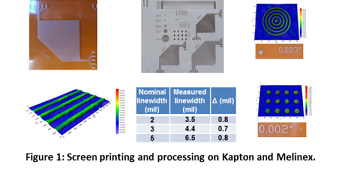
Recent Publication:
1.C Paquet, T Lacelle, B Deore, A J Kell, X Y Liu, I Korobkov, P R L Malenfant (2016) Pyridine-copper (II) formates for the generation of high conductivity copper films at low temperatures. Chem. Commun. 52: 2605-2608.
Takashi Tokumasu
Tohoku University, Japan
Title: Relation between nanoscale structures and transport phenomena in materials of polymer electrolyte fuel cell
Time : 15:45-16:05

Biography:
Takashi Tokumasu is a Professor at the Institute of Fluid Science, Tohoku University. He has his expertise in analyzing nanoscale flow phenomena. Especially, he is focusing on the effect of quantum characteristics of molecules on macroscopic flow and thermodynamic phenomena
Abstract:
Polymer electrolyte fuel cells (PEFC) are used as the next-generation power supply system due to its low environmental burden, high efficiency, and availability for dispersed power systems and emergency use. Transport resistance of reactant and product materials such as proton, oxygen and water is the determining factor of its efficiency and therefore it is necessary to analyze the transport phenomena of proton, oxygen and water in PEFC as fast as possible to develop its performance and efficiency. Computational fluid dynamics (CFD) based on macroscopic transport equations is often used as a conventional numerical analysis. A membrane electrode assembly (MEA) of PEFC, however, consists of gas diffusion layers (GDL), micro porous layers (MPL), catalyst layers (CL), and a polymer electrolyte membrane (PEM), where many nanoscale structures are constructed. In such flow fields, the characteristics of transport phenomena in MEA cannot be analyzed at the macroscopic point of view. Molecular simulation is a powerful tool to analyze these phenomena. In this study these nanoscale transport phenomena are analyzed by large scale molecular dynamics (MD) simulations and the relation between the nanoscale structures and the transport phenomena is analyzed in detail (Figure 1). Especially, the transport phenomena of proton in PEM which has highly anisotropic water structures, oxygen permeability, oxygen scattering and proton diffusivity of ionomer in CL, and the transport phenomena of nanoscale water droplet in MPL were simulated. In the analysis of proton transfer in PEM and ionomer, we considered not only Vehicle mechanism but also Grotthuss mechanism and the diffusivity of proton at various water contents were estimated. This information leads to a new design concept of materials for next generation polymer electrolyte fuel cells.
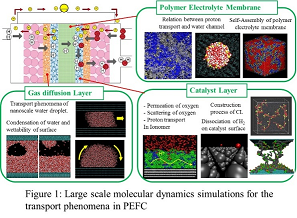
Recent Publications:
1.Kurihara Y, Mabuchi T, Tokumasu T (2017) Molecular analysis of structural effect of ionomer on oxygen permeation properties in PEFC. J. Electrochem. Soc. 164: F628-F637.
2.Mashio T, Ohma A, Tokumasu T (2016) Molecular dynamics study of ionomer adsorption at a carbon surface in catalyst ink. Electrochimica Acta 202: 14-23.
3.Fukushima A, Mima T, Kinefuchi I, Tokumasu T (2015) Molecular dynamics simulation of channel size dependence of the friction coefficient between a water droplet and a nano-channel wall. J. Phys. Chem. C119: 28396-28404.
4.Mabuchi T, Fukushima A, Tokumasu T (2015) A modified two-state empirical valence bond model for proton transport in aqueous solutions. J. Chem. Phys. 143: 014501.
Alessandra Vitale
Polytechnic University of Turin, Italy
Title: Siloxane photopolymers for PCR microfluidics
Time : 16:05-16:25

Biography:
Alessandra Vitale received her MSc degree in Material Engineering from Politecnico di Torino, Italy and in Polymers for Advanced Technologies from Université Joseph Fourier in Grenoble, France, in 2010. She obtained her PhD from Politecnico di Torino, Italy, under the supervision of Professor Roberta Bongiovanni. She has investigated innovative polymers and technologies for the fabrication of microfluidic devices. In 2014, she was engaged as Research Associate in the group of Dr. João Cabral at Imperial College London, UK. In 2016, she joined Politecnico di Torino, Italy as an Assistant Professor. Her research interests include photopolymerization processes and methods for micro- and nano-patterning.
Abstract:
Microfluidic devices represent an emerging technology with a great potential in analytical life sciences. In particular lab-on-a-chip concerning genomic applications has attracted great interest; in such systems there is often the need to provide an efficient DNA amplification by PCR (polymerase chain reaction). Nowadays, polymers are the materials of choice for the fabrication of micro devices for genomic applications. For prototyping and small-scale production, soft lithography—a family of multiple-step techniques based on molding the thermally curable elastomer polydimethylsiloxane (PDMS) is the current gold standard. However, the commercial and common thermally curable PDMS shows some drawbacks that limit its applicability in biotechnology, such as the difficulty in controlling and modifying the surface chemistry and in tuning the physical and mechanical properties of the material. An appealing alternative to thermally curable PDMS prototyping is the use of specially designed UV curable polymers, as photopolymerization is a very fast reaction that leads to the synthesis of highly cross-linked networks in few seconds at room temperature. Moreover, this technique can be applied to a wide variety of photocurable polymers, allowing to select and tune the desired physico-chemical properties of the final device. In the present work, we introduce the use of a class of photocurable siloxane polymers for the fabrication of microfluidic devices for biomedical applications (i.e., PCR). New multifunctional acrylic oligomers are synthesized (Figure 1a) and then photo cross linked. Moreover, copolymerization is used as strategy to optimize the photopolymer properties. The polymers and copolymers synthesized are suitable for bio microfluidics: they are PCR compatible (Figure 1b), highly resistant to temperature and various solvents, transparent, dimensionally stable and essentially non-permeable to water vapor. Therefore, these materials are used to fabricate microfluidic devices (Figure 1c), in which PCR is successfully conducted as proof of principle.
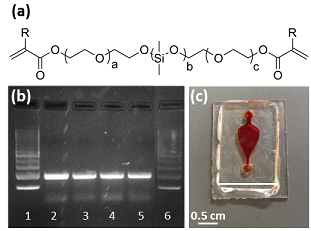
Figure 1: (a) Example of chemical structure of a synthesized acrylic siloxane oligomer. (b) Gel electrophoresis analysis of PCR-products; lanes 1 and 6: DNA ladder, lanes 2-5: addition of a polymer piece into the test tube. (c) Siloxane PCR device filled with colored water.
Recent Publications:
1. Yang J, Vitale A, Bongiovanni R, Nie J (2015) Synthesis and characterization of siloxane photopolymers used for microfluidic devices. New Journal of Chemistry 39: 2532-2540.
Adrianus M M Pruisken
University of Amsterdam, Netherlands
Title: The quantum Hall effect, the theta angle, instantons and all that
Time : 16:25-16:45

Biography:
Adrianus M M Pruisken has contributed to a variety of topics such as quantum critical phenomena, Anderson localization and interaction effects, the Coulomb blockade, the single electron transistors as well as quantum anti-ferromagnets in low dimensions. His microscopic theory of the quantum Hall effect has played a central role in motivating a stream of experimental research on the so-called “plateau-transitions”. His research interests cover the topological and non-perturbative aspects of condensed matter systems, statistical mechanics and quantum field theory.
Abstract:
The quantum Hall effect is an outstanding laboratory for investigating and exploring topological principles in quantum field theory in general, and the strong coupling problems in QCD in particular. In this talk I review some of the highlights and misconceptions spanning more than three decades of research on the subject. This includes the laboratory experiments on the quantum Hall “plateau transitions” as well as the emergence of new concepts such as “super-universality” of quantum Hall physics.
Ali Elkhalifah
Al-Neelain University, Sudan
Title: CO2 adsorption equilibria on calcium exchanged bentonite modified by mono-, di- and triethanolamines
Time : 16:45-17:05

Biography:
Ali E I Elkhalifah has expertise in clay chemistry, adsorption of gases and environmental engineering. He has worked on clay modification and development of low-cost adsorbents improving the CO2 uptake capacity on the modified clays. He has years of experience in research, teaching and administration both in academia and mission-oriented research.
Abstract:
This research work investigates the adsorption characteristics of carbon dioxide on calcium form of bentonite modified by amines at ambient conditions. For this purpose, the native exchangeable cations initially presented in the interlayer space of bentonite were replaced by calcium ions, and then the exchanged bentonite was further treated with protonated mono-, di- and tri-ethanolamines via intercalation process. The characteristics of the prepared hybrids were analyzed by XRD, BET and TGA techniques. XRD results revealed that a gradual increase in the basal spacing of bentonite with an increase in the molar mass of amines was observed. Conversely, low surface area values for bentonite were recorded by BET method. However, the thermal analysis (TGA) of the samples showed a shift to lower values in the amount of the physically adsorbed water as well as its desorption temperature. Static adsorption of CO2 on amine-bentonite adsorbents at ambient conditions showed that the molar mass of amine has an inverse effect on the gas adsorption capacity, where bentonite modified by monoethanolamine adsorbed 0.6 mmol/g compared to 0.4 and 0.3 on that one treated with di- and triethanolamines due to the pore opening effect and a consequential higher surface area.
Recent Publications:
1.Ali E I Elkhalifah (2016) Development and characterization of amine-clay hybrid adsorbents for CO2 capture. Advanced Materials Research 1133: 547-551.
2. Ali E I Elkhalifah (2015) Selective adsorption of CO2 on a re-generable amine-bentonite hybrid adsorbent. Applied Clay Science 101: 213-219.
3. Ali E I Elkhalifah (2013) Effects of exchanged ammonium cations on structure characteristics and CO2 adsorption capacities of bentonite clay. Applied Clay Science 84: 391-398.
4. Ali E I Elkhalifah (2013) Thermal properties of different transition metal forms of montmorillonite intercalated with mono-, di-, and triethanolammonium compounds. Journal of Thermal Analysis and Calorimetry 112: 929-935.
5. Ali E I Elkhalifah (2011) Thermogravimetric analysis of different molar mass ammonium cations intercalated different cationic forms of montmorillonite. Journal of Thermal Analysis and Calorimetry 110: 765-771.
Mohamad Hmadeh
American University of Beirut, Lebanon
Title: Structural features and functions of ZIF crystals made via a reaction diffusion process at room temperature
Time : 17:05-17:25

Biography:
Mohamad Hmadeh was appointed as an Assistant Professor of Chemistry at AUB in January 2014. He obtained his PhD degree in Chemistry (Jan 2010) from the University of Strasbourg (UdS) in France. His research as a graduate student was focused on molecular machines in Supramolecular Chemistry. After graduation, he joined the University of California, Los Angeles (UCLA) as a Post-doctoral fellow in the group of Professor Omar M Yaghi, who is known as one of the pioneers of Metal Organic Frameworks (MOFs). During his stay at UCLA (2010-2012), his research was focused on the design, synthesis, and characterization of novel porous and crystalline materials with exceptional gas sorption, catalysis and electronic properties. He is currently in his second year as a Post-doctoral Researcher in Professor Geoffrey Ozin’s group at the University of Toronto, where he is working on synthesis and evaluation of new photocatalysts for solar fuel production.
Abstract:
We report the synthesis of a range of zeolitic imidazolate frameworks (ZIFs) using a reaction-diffusion framework (RDF). As the imidazolate linkers diffuse into an agar gel matrix containing the divalent metal (zinc and/or cobalt), it reacts to give the corresponding ZIF. The coupling of reaction-diffusion with nucleation, growth and impingement of the growing particles leads into controlling the particle size distribution between 50 nm and 10 μm. By varying the temperature, the concentration of the reagents, and the thickness of the gel matrix, control of the size and morphology of the ZIF crystals is achieved. Also, we show that by using the RDF, we are able to visualize the formation mechanism of ZIF crystals. This novel method for synthesizing ZIFs is rapid, scalable, and environmentally friendly. Furthermore, the effect of cobalt-doping on the photocatalytic properties of ZIF crystals is explored by examining the extent of methylene blue (MB) degradation by each ZIF under visible- light irradiation.
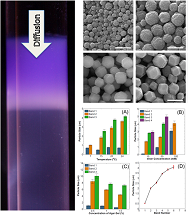
Figure 1: Synthesis of ZIFs via reaction diffusion framework.
Recent Publications:
1.M Al-Ghoul, R Issa, M Hmadeh (2017) Synthesis and structural evolution of metal-organic framework-199 via reaction diffusion process at room temperature. CrystEngComm 19: 608-612.
2.Z Moussa, M Hmadeh, M G Abiad, O H Dib, D Patra (2016) Encapsulation of curcumin in cyclodextrin-metal organic frameworks: Dissociation of loaded CD-MOFs enhances stability of curcumin. Food Chemistry 212: 485-494.
3.D Saliba, A Ezzeddine, R Sougrat, N M Khashab, M Hmadeh, Mazen Al-Ghoul (2016) Synthesis of CdAl layered double hydroxide hierarchical microspheres via a reaction-diffusion framework and their photocatalytic activity for CO2 reduction. ChemSusChem 9: 800-805.
4.A A Jelle, M Hmadeh, P G O’Brien, D D Perovic, G A Ozin (2016) Photocatalytic properties of all four polymorphs of nanostructured iron oxyhydroxides. ChemNanoMater 2: 1047-1054.
Nazim Babacan
Gazi University, Turkey
Title: Influence of grain size on super elasticity and actuation properties of Cu-Al-Mn shape memory alloys
Time : 17:25-17:40

Biography:
Nazim Babacanis is pursuing his PhD studies in the Department of Mechanical Engineering under the supervision of Dr. Benat Kockar and Dr. Selim Turkbas. The topic of his PhD thesis is “Enhancing mechanical properties of Cu-Al-Mn shape memory alloys”. He was a Visiting Scholar at Texas A&M University under the supervision of Dr. Ibrahim Karaman. His studies focused on the actuation properties and thermo-mechanical stability behaviors of Cu-Al-Mn shape memory alloys within the scope of the thesis and found important results that clarify the relationship between microstructure and macro-behavior of these alloys.
Abstract:
Grain size is one of the main microstructural parameters which dictate the shape memory properties of Cu-based shape memory alloys (SMAs). In this study, grain size control of Cu73Al16Mn11 (%) shape memory alloy was achieved via cold rolling–short time post annealing technique. While homogenized material has an average grain size of 900 µm, 260 µm average grain size was obtained after 70% rolling at room temperature and subsequent 950ºC 80 seconds heat treatment. Super elasticity and actuation properties of homogenized and thermo-mechanically treated material were compared by utilizing incremental cyclic tensile and isobaric heating-cooling experiments respectively. It was found that decreasing the grain size had no effect on the superelastic properties of the material, however, residual strains obtained from isobaric heating-cooling experiments decreased prominently. These two contradictory results can be explained by two mechanisms. Since stress level in super elasticity tests are higher (about 300 MPa when transformation starts) than that of in the case isobaric heating-cooling tests (maximum 140 MPa tension stress was applied), stress concentrations at the grain boundaries lead to intergranular fracture owing to high elastic anisotropy of the Cu-based SMAs. On the other hand, strengthening effect of grain size reduction is the main mechanism to increase the dimensional stability by impeding the motion of dislocations that occurs due to the martensitic transformation in isobaric heating-cooling experiments.
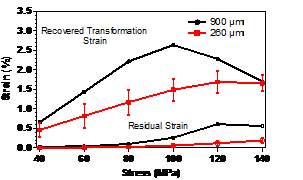
Figure 1: Recovered transformation strain and residual strain as a function of applied stress for materials that have different grain size
